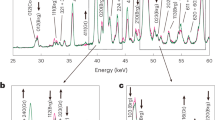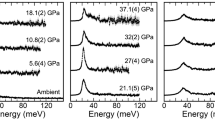Abstract
The velocities of seismic waves in the Earth are governed by the response of the constituent mineral assemblage to perturbations in pressure and stress. The effective bulk modulus is significantly lowered if the pressure of the seismic wave drives a volume-reducing phase transformation1,2. A comparison between the amount of time required by phase transitions to reach equilibrium and the sampling period thus becomes crucial in defining the softening and attenuation of compressional waves within such a two-phase zone3. These phenomena are difficult to assess experimentally, however, because data at conditions appropriate to the Earth’s deep interior are required. Here we present synchrotron-based experimental data that demonstrate softening of the bulk modulus within the two-phase loop of olivine–ringwoodite on a timescale of 100 s. If the amplitude of the pressure perturbation and the grain size are scaled to those expected in the Earth, the compressional-wave velocities within the discontinuities at 410, 520 and, possibly, 660 km are likely to be significantly lower than otherwise expected. The generalization of these observations to aluminium-controlled phase transitions raises the possibility of large velocity perturbations throughout the upper 1,000 km of the mantle.
This is a preview of subscription content, access via your institution
Access options
Subscribe to this journal
Receive 51 print issues and online access
$199.00 per year
only $3.90 per issue
Buy this article
- Purchase on Springer Link
- Instant access to full article PDF
Prices may be subject to local taxes which are calculated during checkout




Similar content being viewed by others
References
Anderson, D. L. Theory of the Earth 279–301 (Blackwell Scientific, 1989)
Jackson, I. in Treatise on Geophysics Vol. 2 (ed. Schubert, G.) 493–525 (Elsevier, 2007)
Vaisnys, J. R. Propagation of acoustic waves through a system undergoing phase transformations. J. Geophys. Res. 73, 7675–7683 (1968)
Dziewonski, A. M. & Anderson, D. L. Preliminary reference Earth model. Phys. Earth Planet. Inter. 25, 297–356 (1981)
Bina, C. R. & Helffrichl, G. Phase transition Clapeyron slopes and transition zone seismic discontinuity topography. J. Geophys. Res. 99, 15853–15860 (1994)
Ringwood, A. E. Phase transformations and the constitution of the mantle. Phys. Earth Planet. Inter. 9, 109–155 (1970)
Katsura, T. & Ito, E. The system Mg2SiO4-Fe2SiO4 at high-pressures and temperatures - precise determination of stabilities of olivine, modified spinel, and spinel. J. Geophys. Res. 94, 15663–15670 (1989)
Irifune, T. Phase transformations in the Earth’s mantle and subducting slabs: Implications for their compositions, seismic velocity and density structures and dynamics. I. Arc 2, 55–71 (1993)
Akaogi, M., Tanaka, A. & Ito, E. Garnet-ilmenite-perovskite transitions in the system Mg4Si4O12-Mg3Al2Si3O12 at high pressures and high temperatures: phase equilibria, calorimetry and implications for mantle structure. Phys. Earth Planet. Inter. 132, 303–324 (2002)
Weidner, D. J. & Wang, Y. in Earth’s Deep Interior: Mineral Physics and Tomography from the Atomic to the Global Scale (eds Karato, S., Forte, A. M., Liebermann, R. C., Masters, G. & Stixrude, L.) 215–235 (American Geophysical Union, 2000)
Weidner, D. J. & Wang, Y. B. Chemical- and Clapeyron-induced buoyancy at the 660 km discontinuity. J. Geophys. Res. 103, 7431–7441 (1998)
Brown, J. M. & Shankland, T. J. Thermodynamic parameters in the Earth as determined from seismic profiles. Geophys. J. R. Astron. Soc. 66, 579–596 (1981)
Chakraborty, S. et al. Enhancement of cation diffusion rates across the 410-kilometer discontinuity in Earth’s mantle. Science 283, 362–365 (1999)
Morris, S. J. S. Coupling of interface kinetics and transformation-induced strain during pressure-induced solid-solid phase changes. J. Mech. Phys. Solids 50, 1363–1395 (2002)
Tamisiea, M. E. & Wahr, J. M. Phase transitions and short timescale sinusoidal motions. Earth Planet. Sci. Lett. 198, 459–470 (2002)
Cherniak, D. J. Rare earth element and gallium diffusion in yttrium aluminum garnet. Phys. Chem. Miner. 26, 156–163 (1998)
Holzapfel, C., Rubie, D. C., Frost, D. J. & Langenhorst, F. Fe-Mg interdiffusion in (Mg,Fe)SiO3 perovskite and lower mantle reequilibration. Science 309, 1707–1710 (2005)
Durham, W. B., Weidner, D. J., Karato, S. & Wang, Y. in Plastic Deformation of Minerals and Rocks Vol. 51 (eds Karato, S. & Wenk, H.-R.) 21–49 (Mineralogical Society of America, 2002)
Li, L. & Weidner, D. J. Energy dissipation of materials at high pressure and high temperature. Rev. Sci. Instrum. 78, 053902 (2007)
Rubie, D. C. & Ross, C. R. Kinetics of the olivine-spinel transformation in subducting lithosphere - experimental constraints and implications for deep slab processes. Phys. Earth Planet. Inter. 86, 223–241 (1994)
Acknowledgements
We thank L. Wang and D. Lindsley for support for this project. We acknowledge support from the National Synchrotron Light Source and the Consortium for Materials Properties in Earth Sciences, and financial support from the US Department of Energy (contract number DE-AC02_98CH10886) and the US National Science Foundation (awards EAR-0711365, EAR652887 and EAR 01-35554). This is MPI publication number 466.
Author information
Authors and Affiliations
Corresponding author
Rights and permissions
About this article
Cite this article
Li, L., Weidner, D. Effect of phase transitions on compressional-wave velocities in the Earth’s mantle. Nature 454, 984–986 (2008). https://doi.org/10.1038/nature07230
Received:
Accepted:
Issue Date:
DOI: https://doi.org/10.1038/nature07230
This article is cited by
-
Ultra-low-velocity anomaly inside the Pacific Slab near the 410-km discontinuity
Communications Earth & Environment (2023)
-
Experimental elasticity of Earth’s deep mantle
Nature Reviews Earth & Environment (2020)
-
Kinetics and detectability of the bridgmanite to post-perovskite transformation in the Earth's D″ layer
Nature Communications (2019)
-
Ab initio molecular dynamic simulation on the elasticity of Mg3Al2Si3O12 pyrope
Journal of Earth Science (2011)
-
Array Triplication Data Constraining Seismic Structure and Composition in the Mantle
Surveys in Geophysics (2009)
Comments
By submitting a comment you agree to abide by our Terms and Community Guidelines. If you find something abusive or that does not comply with our terms or guidelines please flag it as inappropriate.



